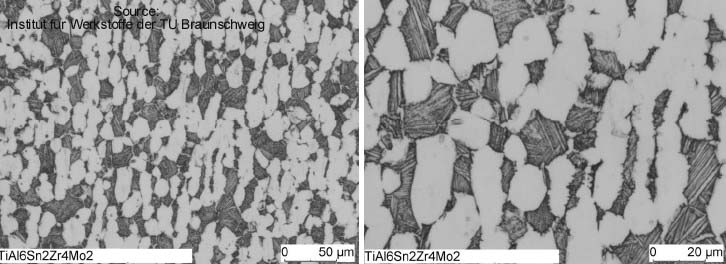
Hello Again Stephan!!!
I added a few more links to the previous post so, ENJOY the read!!! :) :) :)
Here's a brief history for anyone who is interested on Titanium from Thyssen Krupp:
Titanium History
In 1791 a priest and amateur chemist, William Gregor, discovered a new chemical element in the mineral menachanite, a component of the soil near his village. Gregor named the new element "menachite".
In 1795 the German Chemist M.H. Klaproth rediscovered the element, naming it "Titanium" after the Titans, mythical giant children of the god Jupiter. The pure element was first isolated by Liebig from Rutile in 1831: in fact Rutile is pure Titanium Dioxide.
Titanium as a metal was first isolated in 1910. For many years the element titanium remained a chemical curiosity because any attempt to smelt the metal from its ore led to an extremely brittle material with no practical usage, notwithstanding the wide diffusion on the Earth's crust of titanium ores.
In the 1940s and 50s, thanks to the work of Kroll and Hunter the source of fragility was eliminated by avoiding the absorption of elements like oxygen, nitrogen, carbon and hydrogen in titanium. In particular, Kroll understood that titanium requires a special thermochemical process to be extracted from its ore with no contamination from other chemical elements. Such a process is called the Kroll process.Today this is the most widely used system for prime smelting of metallic titanium.
The product of the Kroll process is spongy titanium, still contaminated by some by-products of the smelting method, and prone to atmospheric moisture absorption. Titanium sponge is quickly sealed in drums under vacuum or extra pure argon and as soon as possible it is re-melted to obtain an ingot.
The first titanium ingot was melted in 1953 by means of the vacuum arc re-melting (VAR) furnace. Thanks to the Kroll process and under vacuum melting, titanium ingots are ductile and malleable. The VAR furnace is still widely used to produce titanium ingots from a few kilograms to some tons in weight. Side by side with the VAR furnace, some other machines are used today to produce titanium ingots, in particular the electron beam (EB) furnace and the plasma arc (PA) furnace both introduced in the 1970s).
Titanium as an element represents the number 22 (atomic number) in Mendeleev's table; it has an average atomic weight of 47.90 and a density of 4510 kg/m3. The melting point is about 1668°C and the boiling point is about 3287°C.
Titanium is only used minimally as a metal: in fact its widest usage is as titanium dioxide (synthetic rutile), a plain white inert pigment, which is the main component of many paints and enamels. As a pure element titanium is very soft and ductile and normally is used only for special applications such as in the electronics and associated industries.
Titanium as an industrial metal is used as commercially pure (CP) titanium, i.e. with small additions of oxygen. carbon, nitrogen, hydrogen and iron. CP titanium possesses a strength similar to stainless steel, but displays superior corrosion resistance in certain aggressive media. CP titanium is used mainly in the chemical industry or in closely related industries.
Titanium is also widely used to form alloys. Titanium-based alloys normally contain elements like aluminium, vanadium, tin, molybdenum, iron, silicon and sometimes specialty metals like palladium, ruthenium, tungsten, niobium and so on. Titanium alloys can have strength similar to structural steels. Titanium alloys are normally used in the aeronautical and aerospace industry.
Here's a link to a book titled: "Titanium"... This link compares the High Temperature properties of Ti-6Al-4V, Ti 6242, and IMI 834 or it's american equivalent - TiMetal 834 on page 233:
http://books.google.com/books?id=GwI9ul_wAegC&pg=PA233&lpg=PA233&dq=imi+834&source=web&ots=5_EDa7zKjO&sig=V3wDXoY1lAcTFjyiZFPMWH5Yltk#PPA233,M1This link is to another book titled " Titanium and Titanium Alloys - Fundamentals and Applications" make sure to start on page 22 :) :
http://books.google.com/books?id=okSA1N1xAxgC&pg=PA30&lpg=PA30&dq=titanium+6242&source=web&ots=WfF1AQyfaP&sig=16QQ9cOK_g0cMNzoBhzzLueEbJY#PPA22,M1Here's another book titled : "High Temperature Materials for Power Engineering" which briefly compares IMI 834, and Ti 6242 with respect to tensile and creep properties on page 1719:
http://books.google.com/books?id=Mwe_RU7tmGUC&pg=PA1719&lpg=PA1719&dq=imi+834&source=web&ots=CjmUTACp01&sig=LK8pq_6U5z3BAJINv67Zv9Z4nYsLast but not least:
http://www.thermotech.co.uk/resources/Ti-JMatPro.pdfLike I said before, "Enjoy the Read!!!"
Respectfully,
Henry

